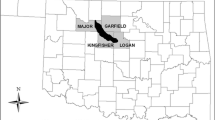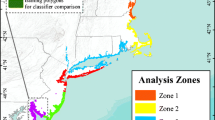Abstract
QuickBird satellite imagery and object-based classification were used to map emergent macrophyte response in wetlands that were partially drawn down during a three-year period (2007–2010) in the Saskatchewan River Delta, Manitoba, Canada. Generalized logistic models were used to classify vegetation genera in three drawdown and three high-water (control) wetlands. User accuracy of models averaged 74 %, and was lower in partial drawdown wetlands (72 %) than in high-water wetlands (77 %). In partial drawdown wetlands, emergent macrophytes (especially Typha spp. and Carex spp.) senesced significantly after the first year of lowered water levels but senescent areas decreased over following years. Plants were not completely dead in dewatered areas and emergent stands recovered by the third year after drawdown. Open water area in the partial drawdown wetlands gradually decreased due to clonal expansion of Sparganium spp. Vegetation areas in high-water wetlands remained unchanged throughout the study period. Although partial water-level drawdowns temporarily influenced the growth of emergent macrophytes they did not expose the seed bank and did not result in substantial, prolonged changes in spatial arrangement of vegetation areas. The combination of high-resolution satellite imagery, object-based classification and logistic modeling was useful for documenting vegetation response to management in these remote, boreal wetland systems.






Similar content being viewed by others
References
Agresti A (2002) Categorical Data Analysis, 2nd edn. John Wiley & Sons, Hoboken, New Jersey, USA
Baatz M, Benz U, Dehghani S, Heynen M, Holtje A, Hofmann P, Lingenfelder I, Mimler M, Sohlbach M, Weber M, Willhauck G (2004) User Guide 4, Ecognition Elements. Definiens Imaging Publication. http://www.gis.unbc.ca/help/software/ecognition4/ELuserguide.pdf. Accessed September 2009
Baschuk MS (2010) Effects of water-level management on the abundance and habitat use of waterfowl and marsh birds in the Saskatchewan River Delta, Manitoba, Canada. Thesis. University of Manitoba. Winnipeg, Manitoba, Canada
Baschuk MS, Koper N, Wrubleski DA, Goldsborough G (2012) Effects of water depth, cover, and food resources on habitat use of marsh birds and waterfowl in boreal wetlands of Manitoba, Canada. Waterbirds 35:44–55
Bornette G, Amoros C (1996) Disturbance regimes and vegetation dynamics: role of floods in riverine wetlands. Journal of Vegetation Science 7:615–622
Bukata RP, Bruton JE, Jerome JJ, Harris WS (1988) An evaluation of the impact of persistent water level changes on the areal extent of Georgian Bay/North Channel marshlands. Environmental Management 12:359–368
Carter GA (1993) Responses of leaf spectral reflectance to plant stress. American Journal of Botany 80:239–243
Cserhalmi D, Nagy J, Kristóf D, Neidert D (2011) Changes in a wetland ecosystem: a vegetation reconstruction study based on historical panchromatic aerial photographs and succession patterns. Folia Geobotany 46:351–371
Dirschl HJ (1972) Geobotanical processes in the Saskatchewan River Delta. Canadian Journal of Earth Sciences 9:1529–1549
Dirschl HJ, Coupland RT (1972) Vegetation patterns and site relationships in the Saskatchewan River Delta. Canadian Journal of Botany 50:647–675
Efron B (1982) The jackknife, the bootstrap and other resampling plans. Society of Industrial and Applied Mathematics CBMS-NSF Monographs No. 38, Philadelphia, Pennsylvania, USA.
Ervin M (2011) Population characteristics and habitat selection of muskrats (Ondatra zibethicus) in response to water level management at the Summerberry Marsh Complex, The Pas, Manitoba, Canada. Thesis, Iowa State University, Ames, Iowa, USA
Garmin Ltd. 2007. GPSmap 76CSx mapping gps owner’s manual. Garmin International Inc. www.garmin.com/manuals/GPSMAP76CSx_OwnersManual.pdf. Accessed June 2010
Ghioca-Robrecht DM, Johnston CA, Tulbure MG (2008) Assessing the use of multiseason QuickBird imagery for mapping invasive species in a Great Lakes coastal marsh. Wetlands 28:1028–1039
Gilmore MS, Wilson EH, Barrett N, Civco DL, Prisloe S, Hurd JD, Chadwick C (2008) Integrating multi-temporal spectral and structural information to map wetland vegetation in a lower Connecticut River tidal marsh. Remote Sensing of Environment 112:4048–4060
Harvey KR, Hill JE (2001) Vegetation mapping of a tropical freshwater swamp in the Northern Territory, Australia: a comparison of aerial photography, Landsat TM and SPOT satellite imagery. Remote Sensing of Environment 22:2911–2925
IBA Canada (2009) Canadian important bird areas: the Saskatchewan River Delta, The Pas, Manitoba. www.ibacanada.com. Accessed May 2010
Kantrud H, Millar JB, van der Valk AG (1989) Vegetation of wetlands of the Prairie Pothole Region. In: van der Valk AG (ed) Northern Prairie Wetlands. Iowa State University Press, Ames, Iowa USA, pp 132–187
Kamagata N, Hara K, Mori M, Akamatsu Y, Li Y, Hoshino Y (2007) A new method of vegetation mapping by object-based classification using high resolution satellite data. Journal of the Japan Society of Photogrammetry and Remote Sensing 45:43–49
Kelly M, Shaari D, Guo Q, Liu D (2004) A comparison of standard and hybrid classifier methods for mapping hardwood mortalities in areas affected by “Sudden Oak Death”. Photogrammetric Engineering and Remote Sensing 70:1229–1239
Li S, Perzeshki SR, Goodwin R (2004) Effects of soil moisture regimes on photosynthesis and growth in cattail (Typha latifolia). Acta Oecologia 25:17–22
Lillesand TM, Kiefer RW, Chipman JW (2008) Remote Sensing and Image Interpretation, 6th edn. John Wiley and Sons, Hoboken, New Jersey, USA
Lindgren CJ (2001) Community conservation plan for The Pas – Saskatchewan River Delta. Report prepared for the Canadian Nature Federation, Bird Studies Canada, Bird Life International and the Manitoba Naturalists Society. 51 pp
Lopez RD, Edmonds CM, Neale AC, Slonecker TS, Jones KB, Heggem DT, Lyon JG, Jaworski E, Garofalo D, Williams D (2004) Accuracy assessments of airborne hyperspectral data for mapping opportunistic plant species in freshwater coastal wetlands. In: Lunetta RS, Lyon JG (eds) Remote Sensing and GIS Accuracy Assessment. CRC Press, New York, New York, USA, pp 253–267
May AMB, Pinder JE, Kroh GC (1997) A comparison of LANDSAT Thematic Mapper and SPOT multi-spectral imagery for the classification of shrub and meadow vegetation in Northern California, USA. International Journal of Remote Sensing 18:3719–3728
McCarthy J, Gumbricht T, McCarthy TS (2005) Ecoregion classification in the Okavango Delta, Botswana from multitemporal remote sensing. International Journal of Remote Sensing 26:4339–4357
McCulloch CE, Searle SE (2001) Generalized, Linear, and Mixed Models. John Wiley & Sons, New York, New York, USA
Midwood JD, Chow-Fraser P (2010) Mapping floating and emergent aquatic vegetation in coastal wetlands of Eastern Georgian Bay, Lake Huron, Canada. Wetlands 30:1141–1152
Mitsch WJ, Zhang L, Anderson CJ, Altor AE, Hernández ME (2005) Creating riverine wetlands: ecological succession, nutrient retention, and pulsing effects. Ecological Engineering 25:510–527
Morozova GS, Smith ND (1999) Holocene avulsion history of the lower Saskatchewan fluvial system, Cumberland Marshes, Saskatchewan-Manitoba, Canada. In: Smith ND, Rogers J (eds) Fluvial Sedimentology VI. Blackwell Science Ltd., Oxford, UK, pp 231–249
Morozova GS, Smith ND (2003) Organic matter deposition in the Saskatchewan River floodplain (Cumberland Marshes, Canada): effects of progradational avulsions. Sedimentary Geology 157:15–29
Natural Resources Canada (2009) The Atlas of Canada. http://atlas.nrcan.gc.ca/auth/english/maps/environment/land/permafrost. Accessed February 2011
Nygaard B, Ejrnæs R (2004) A new approach to functional interpretation of vegetation data. Journal of Vegetation Science 15:49–56
Otte ML (2001) What is stress to a wetland plant? Environmental and Experimental Botany 46:195–202
Partners FOR the Saskatchewan River Basin (2009) The state of the Saskatchewan River Basin. Partners FOR the Saskatchewan River Basin Report. www.saskriverbasin.ca/page.php?page_id=70&PHPSESSID=vp48ugdtta71gng4mkn166b296. Accessed May 2010
Prowse TD, Conly FM (2000) Multiple-hydrologic stressors of a northern delta ecosystem. Journal of Aquatic Ecosystem Stress and Recovery 8:17–26
Quinlan C, Mulamoottil G (1987) The effects of water level fluctuations on three Lake Ontario shoreline marshes. Canadian Water Resources Journal 12:64–77
Rokitnicki-Wojcik D, Wei A, Chow-Fraser P (2011) Transferability of object-based rule sets for mapping coastal high marsh habitat among different regions in Georgian Bay, Canada. Wetlands Ecology and Management 19:223–236
Ryherd S, Woodcock CE (1996) Combining spectral and texture data in the segmentation of remotely sensed images. Photogrammetric Engineering and Remote Sensing 62:181–194
SAS Institute Inc (2008) SAS/STAT user guide. SAS Institute Inc, Cary, North Carolina, USA
Seabloom EW, van der Valk AG, Moloney KA (1998) The role of water depth and soil temperature in determining initial composition of prairie wetland coenoclines. Plant Ecology 138:203–216
Squires L, van der Valk AG (1992) Water-depth tolerances of the dominant emergent macrophytes of the Delta Marsh, Manitoba. Canadian Journal of Botany 70:1860–1867
Stewart-Oaten A, Bence JR (2001) Temporal and spatial variation in environmental impact assessment. Ecological Monographs 71:305–339
Thomas N, Hendrix C, Congalton RG (2003) A comparison of urban mapping methods using high-resolution digital imagery. Photogrammetric Engineering and Remote Sensing 69:963–972
Toner M, Keddy P (1997) River hydrology and riparian wetlands: a predictive model for ecological assembly. Ecological Applications 7:236–246
van der Valk AG, Davis CB (1978) The role of seed banks in vegetation dynamics of prairie glacial marshes. Ecology 59:322–335
van der Valk AG (1991) Response of wetland vegetation to change in water level. In: Finlayson CM, Larsson T (ed) Wetland Management and Restoration – Proceedings of a Workshop, Sweden 1990, pp 7-16
van der Valk AG (2000) Vegetation dynamics and models. In: Murkin HR, van der Valk AG, Clark WR (eds) Prairie Wetland Ecology: the contribution of the Marsh Ecology Research Program. Iowa State University Press, Ames, Iowa, USA, pp 125–161
van der Valk AG (2012) The Biology of Freshwater Wetlands, 2nd edn. Oxford University Press, Oxford, UK
Watchorn KE (2011) Effects of water level management on water chemistry and primary production of boreal forest marshes in northern Manitoba, Canada. Thesis, University of Manitoba, Winnipeg, Manitoba, Canada
Yamamura Y (1999) Transformation using (x + 0.5) to stabilize the variance of populations. Researches on Population Ecology 41:229–234
Acknowledgements
Project funding was provided by Manitoba Hydro, Ducks Unlimited Canada, Manitoba Conservation and Water Stewardship, Natural Sciences and Engineering Research Council of Canada, and the Kelsey Conservation District. We thank Bill Tedford for his technical assistance with this project. We are indebted to the staff of Ducks Unlimited Canada in The Pas, including Shaun Greer, Robin Reader, Dave Clayton, Chris Smith, and Dave White. Thank you to our field assistants Heath Brown, Quinn Constant, and Jonathan Harris. Garth Ball, Dale Cross, and Cam Hurst from Manitoba Conservation and Water Stewardship provided equipment and allowed us to use their field camp and bunkhouse.
Author information
Authors and Affiliations
Corresponding author
Rights and permissions
About this article
Cite this article
Baschuk, M.S., Ervin, M.D., Clark, W.R. et al. Using Satellite Imagery to Assess Macrophyte Response to Water-level Manipulations in the Saskatchewan River Delta, Manitoba. Wetlands 32, 1091–1102 (2012). https://doi.org/10.1007/s13157-012-0339-z
Received:
Accepted:
Published:
Issue Date:
DOI: https://doi.org/10.1007/s13157-012-0339-z




